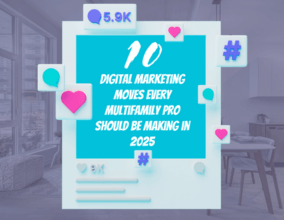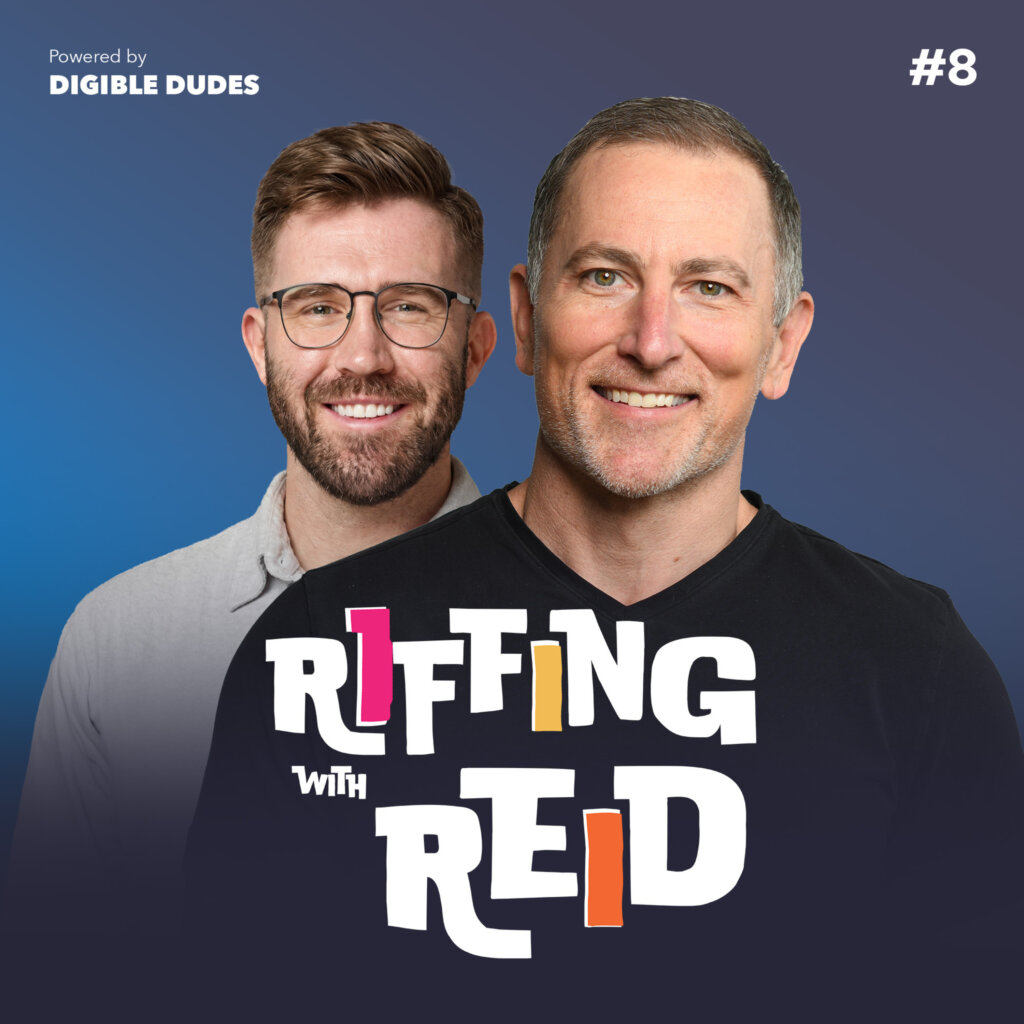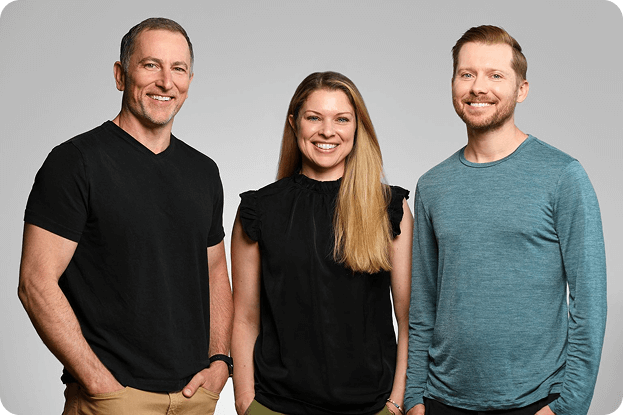If you’ve ever looked at a competitor’s marketing strategy and thought, “Wait… should we be doing that too?”, you’re not alone. In the fast-moving world of multifamily marketing, it’s easy to feel like new trends and tactics pop up overnight, and staying ahead can feel like a full-time job.
But here’s the good news: you don’t have to do everything, just the right things. This list of 10 digital marketing moves will help you audit your current efforts, stay ahead of the curve, and feel confident that your properties are set up for success in 2025.
1. Optimize Your Google Business Profile (GBP) Weekly
Your Google Business Profile (GBP) isn’t just another listing, it’s one of the most powerful digital marketing tools you have for driving local traffic, increasing visibility, and ultimately, boosting occupancy. In fact, your GBP is often the very first impression prospects get of your community.
When optimized and actively maintained, a GBP can dramatically improve your rankings on Google Maps and in local search results. But if left untouched or edited carelessly, your profile risks dropping in search rankings or, even worse, being unverified or suspended by Google.
And here’s the kicker: GBP suspensions are way up in 2024. Over the past few months, there’s been a major surge in de-verifications and suspensions across industries, including multifamily. Google has offered little explanation for this spike, but experts believe it could be tied to system glitches and more aggressive algorithm updates.
To learn more about how to protect yourself from these suspensions, read our blog post “What Multifamily Marketers Need to Know About the Latest Google Business Profile Suspensions”.
Whatever the cause, one thing is clear: If your profile gets suspended, you’re virtually invisible online, just when prospective renters are searching for their next home. Recovering from suspension isn’t quick either; appeals are currently taking up to five weeks to resolve.
💡 Pro Tip: Consistency & caution are your best friends
Here’s how to stay proactive and protected:
- Post Weekly: Treat your GBP like a social feed. Rotate content ideas like:
- 📸 Resident event recaps
- 👋 Staff spotlights or new hire announcements
- 🗺 Shoutouts to nearby businesses or local attractions
- ⏰ Holiday office hour updates
- 🛠 Seasonal maintenance tips
- Maintain NAP Consistency: Your Name, Address, and Phone number must match exactly across all platforms (website, ILS listings, social media, etc.).
- Be Careful With Edits: Avoid making unnecessary changes to your core info (NAP, website URL, primary category). Google has been known to suspend listings even for minor updates lately.
- Prioritize Visuals: Update your photos seasonally to reflect current amenities, landscaping, and community life.
- Use Automation Tools: If you’re managing multiple properties, tools like Fiona’s GBP AI Posts can automate fresh content posting and ensure every listing stays active and optimized without piling more work onto your team.
A well-maintained GBP isn’t just about staying visible, it’s about staying protected. Regular updates help you climb in search rankings and lower your risk of suspension. In today’s environment, where being offline for even a few weeks can mean lost leases, a proactive GBP strategy is essential.
2. Diversify Paid Media Beyond Just Google Search
Google Search Ads are great, but they’re only one piece of the paid media puzzle. If your entire paid strategy is focused on bottom-of-the-funnel search intent, you’re missing a huge opportunity to influence renters before they even start actively searching. In multifamily, the decision to move is often influenced by lifestyle changes, subtle brand recognition, and emotional pull, not just price and floor plans.
That’s where paid social and video platforms like Meta (Facebook & Instagram), TikTok, and YouTube come in. These channels let you build awareness, create demand, and position your property in the renter’s mind well before they type “apartments near me” into Google.
With algorithmic targeting based on user behavior, interests, and life events, these platforms are ideal for reaching renters in the exploration and consideration phases of the journey.
Think of it like this: Google is where renters go when they’re ready to lease. Meta, TikTok, and YouTube are where you help them decide that they’re ready to lease, and that your community is worth remembering.
💡 Pro Tip: Take a full, funnel approach
Reallocate 10–20% of your total media budget toward awareness, stage campaigns that run on platforms like:
- 🎥 YouTube pre-roll ads showcasing your amenities
- 📱 Instagram Reels or Stories highlighting your local neighborhood
- 🏡 TikTok videos with walk-throughs, pet-friendly promos, or staff intros
These placements not only drive traffic but also build trust and brand recall in highly competitive markets, especially among Gen Z and Millennial renters who expect more than static ads and pricing tables.
And here’s the bonus: When you combine this upper-funnel approach with your search campaigns, you’ll likely see improved conversion rates overall.
Why? Because you’ve already warmed up your audience before they ever click a search ad.
If you’re only showing up when renters are searching, you’re late to the game. Diversify your paid media strategy to meet future residents earlier and more often.
3. Track Performance by Property, Not Just Portfolio
In multifamily, no two properties are exactly alike. That luxury high-rise in a booming downtown corridor? It’s playing a very different game than the suburban garden-style community with a slower lease-up. When you average their performance into one portfolio-wide metric, you lose the nuance that makes strategic optimization possible.
Blended reporting might look neat on paper, but it hides crucial insights. A property that’s overperforming can mask one that’s struggling. A campaign that’s thriving in Atlanta might be flopping in Phoenix. And without visibility into which property is driving results (or dragging down performance), you’re flying blind and risking misallocated budgets, missed opportunities, and frustrated stakeholders.
To make smart, data-driven decisions, you need to see the full picture at the property level, not just the highlight reel.
💡 Pro Tip: Adopt a reporting structure that gives you granular visibility
The goal is to measure what matters most per property, like:
- Cost per lead (CPL)
- Lead to lease conversion rates
- Impressions, clicks, and engagement by channel
- Budget pacing vs. actual spend
This level of clarity means you can optimize spend with confidence, fix underperforming properties faster, and identify which strategies should scale across the portfolio. You’ll also have cleaner data to share with your leadership team, and that kind of transparency builds serious trust.
Need help building a dashboard that works for your team? Let’s chat about what metrics matter most for your portfolio, and how to surface them clearly and consistently.
4. Run a Monthly Website Audit
Your property website is your digital front door, and if it’s jammed, dirty, or confusing, prospects will simply walk away. The smallest issues (think broken links, slow page speeds, blurry photos, or outdated CTAs) can quietly erode your credibility, hurt your SEO rankings, and ultimately cost you leases.
In a fast, moving market, you can’t afford to let simple technical problems stack up. Search engines notice these red flags too: Google favors fast, mobile friendly, user-focused sites. If you’re not monitoring and maintaining your site regularly, you’re risking both visibility and conversion rates.
💡 Pro Tip: Make website audits a non-negotiable part of your monthly marketing checklist
Here’s a quick workflow you can follow:
- Technical Audit: Use free or low cost tools like ahrefs, PageSpeed Insights, or Screaming Frog to scan for broken links, crawl errors, or slow loading pages.
- Mobile Experience Check: Test your site on a real phone (not just desktop) every month. Are pages loading fast? Is navigation intuitive? Does your leasing form work perfectly on mobile?
- Visual Content Review: Rotate homepage banners, refresh event photos, and double check that all floorplans and specials are current and correctly linked.
- SEO Elements: Check that your meta titles, descriptions, and alt text still align with your leasing priorities (especially if you’ve updated availability or offers).
- Conversion Pathways: Fill out a contact form, schedule a tour, or use your chatbot as if you’re a prospect. Make sure the experience is fast, friendly, and error free.
You can do a basic check yourself, or if time is tight (and we know it usually is), lean on your agency partner. At Digible, for example, we monitor site health and flag any issues proactively, so small problems don’t snowball into lost leases.
Right now we’re giving away FREE SEO Audits! All you need to do is fill out this form here and we’ll put together a comprehensive SEO audit, 100% free. No strings attached! Get expert insights, tailored recommendations, and a roadmap to higher rankings, completely free!
5. Refresh Floorplan Meta Descriptions
In many markets, ILS listings like Apartments.com and Zillow are outranking property websites on Google. That’s a problem because when a prospect searches for “2, bedroom apartment near me,” you want your own site (not just third party listings) to show up high in the results.
One of the easiest wins? Refreshing your floorplan pages with better meta descriptions and on-page copy. Old, generic descriptions like “Spacious floorplan available” won’t cut it anymore. Search engines and renters reward specificity. Plus, strong meta descriptions act like mini ads, enticing people to click through to your site instead of someone else’s.
💡 Pro Tip: Think of your meta descriptions as micro advertisements for each floor plan
Here’s how to make them count:
- Be Specific: Include unique features, like walk in closets, quartz countertops, smart home technology, or mountain views.
- Use Emotional Hooks: Highlight benefits that matter to renters, like pet friendly perks, proximity to parks, or high end amenities.
- Include the Property Name and Location: This helps with SEO and reassures the renter they’re looking at the right spot.
- Stay Within Character Limits: Aim for around 155–160 characters so your description doesn’t get cut off on search results.
Example upgrade:
❌ Old Meta: “2 bedroom floorplan available.”
✅ New Meta: “Spacious 2 bedroom with mountain views, quartz counters, and a walk in closet, available now at The Paloma in Denver.”
And don’t stop at the meta descriptions!
Refresh your on page copy too. Add details that answer common renter questions (“How big is the balcony?” “Is there in unit laundry?”) and naturally weave in location specific terms.
If you wouldn’t click your own listing, why would a prospect?
Giving your floorplans a little SEO TLC can drive more organic traffic, keep renters on your site longer, and ultimately lead to more qualified leads for your leasing team.
6. Build a “Smart” Retargeting Funnel
Most renters don’t lease after their first website visit. In fact, they might visit three, five, even ten times before reaching out or scheduling a tour. If you’re only targeting brand new prospects and ignoring your warm leads, you’re leaving a lot of leases on the table.
That’s where a smart retargeting funnel comes in. Instead of showing every visitor the same generic “Lease Now!” ad, you customize your messaging based on how far along they are in their journey.
Behavioral retargeting increases relevancy, keeps your brand top of mind, and moves prospects down the leasing funnel faster and more efficiently.
💡Pro Tip: Start by segmenting your retargeting audiences based on what they did on your site
- Homepage visitors: These folks are early in their search. Serve them broad branding ads that highlight your top amenities or community vibe.
- Floorplan or pricing page viewers: They’re getting serious. Show ads with unit availability, limited time specials, or “Schedule a Tour” CTAs.
- Tour sign up abandoners: Almost there! Serve urgent messaging like “Tours are filling fast, secure your spot today!” or offer incentives like waived application fees.
❗️Bonus Move: Set up dynamic creative that automatically pulls in floorplan names, pricing, or move in specials based on what a prospect last viewed. (Platforms like Meta and Google Ads make this easy.)
Not all retargeting is created equal. A smart funnel meets renters where they are, nudges them toward action, and creates a smoother, more natural leasing journey. Plus, it maximizes your ad spend by focusing your dollars on prospects who already know (and like) you.
7. Incorporate AI into Content Creation, Strategically
AI is no longer a futuristic concept, it’s an everyday tool. Platforms like ChatGPT, Jasper, and even Canva’s Magic Write are making it faster and easier than ever to generate content across social media, blogs, Google Business Profile posts, and more.
But here’s the catch: AI is a productivity tool, not a replacement for strategic thinking. While AI can help speed up content creation, it still needs strong human oversight to ensure the output is accurate, on brand, engaging, and compliant with multifamily regulations like Fair Housing.
Without careful editing, AI generated content can sound robotic, include outdated information, or (worse) introduce compliance risks. Smart marketers know that the winning formula is using AI to accelerate workflows, not to replace critical thinking or creativity.
💡Pro Tip
- Use AI for early drafts of social media captions, blog outlines, ad headlines, or property descriptions.
- Then review and refine the content carefully:
✅ Tone check: Does it match your brand’s voice?
✅ Accuracy check: Are the details about your property, amenities, pricing, and promotions correct?
✅ Compliance check: Are you steering clear of any Fair Housing violations (e.g., language around family status, disabilities, race, etc.)?
❗️Bonus Move: Consider tools specifically built for multifamily marketing. Fiona’s GBP AI Posts from Digible, for example, allow you to auto generate Google Business Profile content at scale, but with expert oversight baked in to ensure everything stays compliant, localized, and property specific.
AI should be your sidekick, not your substitute. When used strategically, it allows you to do more with less, freeing your team to focus on big picture strategy while maintaining the authenticity and accuracy that renters expect.
8. Make Your Website ADA & Fair Housing Compliant
In multifamily marketing, compliance isn’t just a legal checkbox, it’s a reflection of your brand’s integrity and inclusivity. An ADA compliant and Fair Housing compliant website ensures that all prospects, regardless of ability, background, or circumstance, can access and engage with your property information.
From a legal perspective, the risk of non compliance is very real:
- ADA violations can lead to lawsuits, heavy fines, and reputational damage.
- Fair Housing violations (even unintentional ones) can result in costly penalties and serious brand trust issues.
Beyond risk mitigation, compliant websites also tend to rank better in search results. Google rewards sites that offer better user experiences, including accessibility features like alt text for images, properly structured headers, and keyboard navigation, all of which improve SEO performance.
💡Pro Tip
- Use accessibility tools like accessiBe to audit and enhance your website’s ADA compliance (think screen reader compatibility, color contrast, font sizing, etc.).
- Scan your site for Fair Housing risks using a specialized tool like Digible’s Fair Housing Compliance Tool. It automatically checks your content for language or imagery that could inadvertently create compliance issues.
- Prioritize the fixes:
- Start with high impact issues that could block access to critical information (floorplans, contact forms, application pages).
- Then work your way toward more nuanced updates, like adjusting language to ensure inclusivity and neutrality across your site.
A compliant website is a win, win: it protects your brand, expands your potential renter base, improves SEO, and builds goodwill with your community.
Taking the time to invest in ADA and Fair Housing compliance now can save you thousands later, and show renters that your community is truly for everyone.
9. Embrace Entity Based SEO
SEO is no longer just about cramming the right keywords into your website. As AI driven search (like Google’s Search Generative Experience) evolves, Google is prioritizing “entities”, people, places, things, and the relationships between them.
In other words: context is now king.
Instead of simply asking, “Did they mention ‘luxury apartments Denver’ enough times?”, Google’s algorithms are now asking, “How well does this page fit into the broader conversation about living in downtown Denver near Union Station, Coors Field, and local hotspots?”
For multifamily marketers, this means you need to position your property within a web of recognizable local entities, not just focus on keywords.
👉 Building these connections helps your site
- Show up in more nuanced, longer tail search queries.
- Appear in AI generated answers and overviews.
- Strengthen your relevance and authority in your local market.
💡 Pro Tip
- Integrate related local entities naturally into your website content. Mention nearby neighborhoods, shopping centers, schools, parks, and local businesses by name (e.g., “Minutes from Sloan’s Lake Park and Highlands Square in Denver”).
- Write neighborhood guides or “nearby attractions” blogs that link your property to known landmarks and popular destinations.
- Use schema markup to reinforce these relationships on the backend.
- Examples:
- “Apartment” schema
- “Place” schema
- “LocalBusiness” schema
- This structured data helps Google quickly understand your property’s connections without having to guess.
- Examples:
By weaving your property into the fabric of the local community online and signaling it clearly to Google, you build stronger relevance, increase visibility in AI and organic search results, and stand out in a crowded rental market.
10. Ask Residents for Reviews, Strategically
Positive reviews aren’t just vanity metrics, they directly impact your property’s local SEO rankings, click through rates, and leasing conversions.
Today’s renters are savvy: 74% of people check at least 2 review sites before making a decision (according to BrightLocal). If your Google Business Profile or Yelp page is loaded with recent, authentic five star reviews, prospects are far more likely to trust you and book a tour.
But here’s the catch: Timing and approach are everything.
Randomly blasting residents with review requests once a year won’t cut it. Worse, it can lead to low quality reviews or a flood of complaints if you catch people at a bad moment (like right after a maintenance mishap).
💡 Pro Tip
- Set up automated review requests that trigger at positive moments in the resident journey:
- After a maintenance request is successfully completed.
- After a prospect finishes a tour (especially if they leave positive feedback onsite).
- After a renewal is signed.
- Keep the ask short, sweet, and personalized.
Example: “Thanks for visiting [Property Name] today! We’d love to hear about your experience. If you have 60 seconds, could you leave us a quick review? It really helps future residents find their new home!” - Make it easy. Include direct links to your Google or Yelp review pages.
- Mix up your platforms. Encourage reviews not just on Google, but also on Yelp, Apartments.com, and Facebook to diversify your presence across important decision making channels.
A proactive, strategic review generation process turns your happy residents into your best marketing asset, boosting trust, visibility, and occupancy without paying for another click.
Ready to Stop Wondering if You’re Falling Behind?
You don’t need to chase every trend or hire five more vendors to stay competitive. You just need a strong digital foundation, consistent execution, and a partner who understands the multifamily landscape.
👉 Let’s talk about how Digible can help or if you’re ready to dive deeper, check out our SEO, Paid Media, and Fiona data solutions tailored for multifamily marketers.








